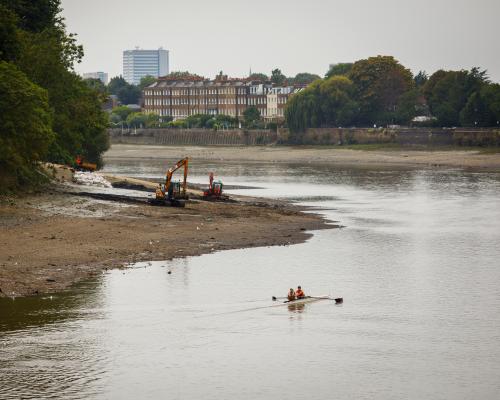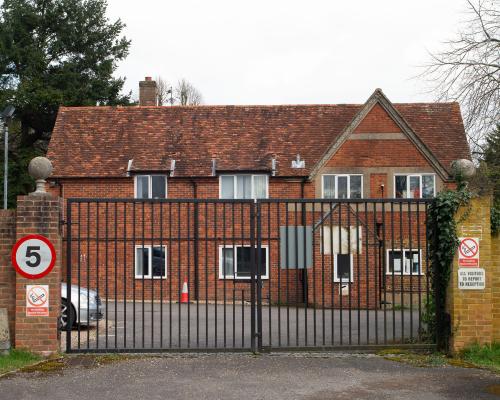
Imagine several mounds of congealed grot (consistency akin to the insides of a leisure centre shower drain, or the world’s most disgusting pedal bin) washed up on the southern foreshore of the River Thames in London at low tide. Then, imagine a tourist from New Zealand stopping to take a picture and several videos of said grot – presumably to show his kin back home what louts we are – while diggers deposit big black clods of the stuff into the bed of a truck, and rowers glide blithely by.
Imagine it, or see it for yourself. Welcome to “Wet Wipe Island”, London’s newest – and grimmest – landmark.
Forget the Grecian torsos and brute machiavellianism of Love Island. At the foot of Hammersmith Bridge, the show of the summer is fast becoming the excavation of this very different type of island, a stretch of the Thames that is saturated with enough discarded wet wipes to form two tennis courts.
“I’m shocked, to say the least,” says the 31-year-old architectural designer Adam Perry, whose office is just off the bridge. “To be honest, it makes me emotional and frustrated that people are actually flushing their wet wipes instead of disposing of them correctly. It’s slightly embarrassing. Don’t get me wrong, the majority of Londoners are doing their part, but all it takes is a certain percentage to do stuff like that and it affects us all.”
Unfortunately, the numbers suggest that it is more than just a small percentage who are flushing these environmental terrors down the toilet. Grace Rawnsley, the director of sustainability for the Port of London Authority (PLA), which has taken on the gruesome task of dredging up the wet wipes, estimates that more than 180 tonnes – roughly equivalent to 15 of the capital’s doubledecker buses – will be pulled from the river in the next month.
It’s no wonder, then, that Wet Wipe Island – which has its own Google Maps listing (it’s recorded as a cultural landmark), should you struggle to find your way from the tube station – has garnered an unlikely notoriety in recent days. “My ears pricked up when I heard Hammersmith on the news,” says 62-year-old Russell Page, who is nursing a pint outside the Rutland Arms, a pub with expansive views of the river and now, this first-of-its-kind cleanup operation. “I had no idea what they were doing over there until the other day. It’s not until you see [the detritus] up close that [you realise] it’s so dreadful.”
The self-financed PLA – which declined to say how much the cleanup will cost, though admitted it was “in the hundreds of thousands” – is using a “rake-and-shake” method to sift the wipes, which get caught in the bucket of the digger like rotten string cheese, from the river sediment. They will eventually be put into landfill. “The sediment will be what’s containing the aquatic invertebrates,” says Rawnsley. “We’re removing that contaminated layer while retaining as much of the foreshore as we can.”
If you think that sounds like an unpleasant job, spare a thought for volunteers from the environmental charity Thames21, who have fished about 140,000 wet wipes by (gloved) hand from the river since 2017. When wipes are flushed into the sewage system, and the sewage system overflows in heavy rain, “[it] throws them out into the Thames”, explains the charity’s Liz Gyekye. Because this part of the river is a slow-moving bend, they gather en masse – and their impact is “devastating for wildlife and potentially humans”, says Gyekye. In short, “they shouldn’t be in the environment.”
Whether they’re used for makeup removal or nappy changing, most wipes sold in the UK contain plastic, which invariably ends up in the systems of the invertebrates, fish and birds that call the Thames home. Every year, Thames Water clears 3.8bn wipes from its network at an annual cost of £18m. Although the government has pledged to ban wet wipes containing plastic, progress has stalled since last year’s general election.
Still, it’s not all bad. “The story of this river is the story of recovery,” says Rawnsley. Where parts of the Thames were declared “biologically dead” in the 1950s, today, with 125 different species of fish and 92 species of bird, “it’s on its way back to being miraculous – but we still have further to go.”
Of course, it’s not just wet wipes that are blighting the UK’s second-longest river. Most Londoners have a pub story about the most menacing thing they’ve spotted in the Thames. (My own was a lifesize crucifix, which I watched being thrown into the water from Vauxhall Bridge.) “I’ve seen lots of horrible things floating,” says a 69-year-old passerby, Doune Storey. “Tampons, Durex, nappies. It’s got to go somewhere – it’s not just going to go into the ether. We’ve all got to be more responsible.”
Earlier this year, over the course of a two-day environmental survey, the PLA pulled 29 bikes (15 of which were Lime bikes), a park bench, a wheel clamp and an empty safe from the river.
As for Wet Wipe Island, Rawnsley hopes it will soon be wiped from the map once and for all: “Without sounding too virtuous, we’re working towards making the Thames the river that everyone wants it to be.” Who knows, maybe in a few years we’ll be living la vie parisienne and swimming in it. Maybe.







